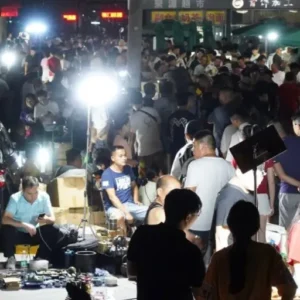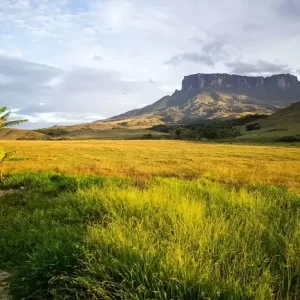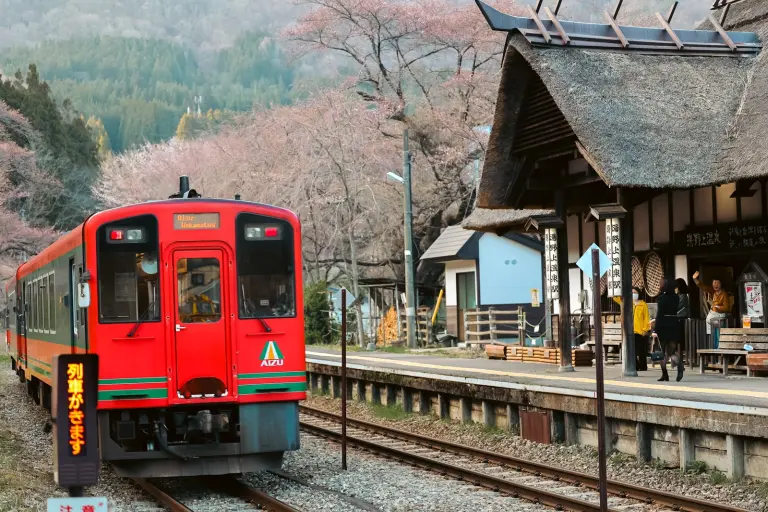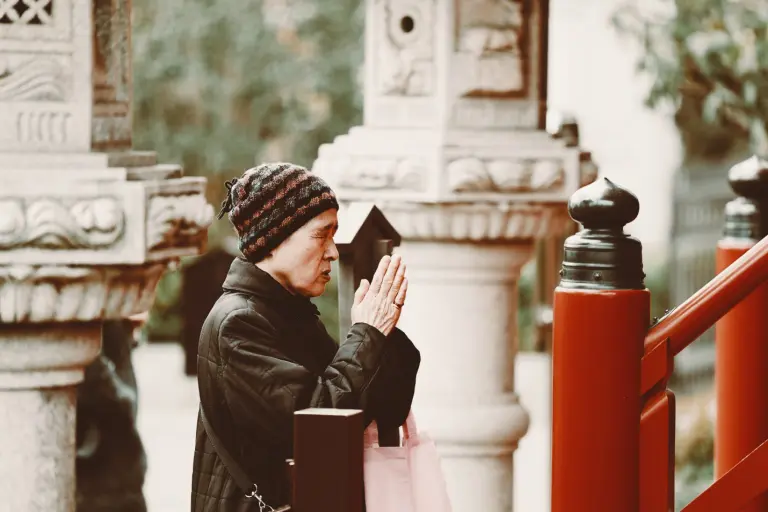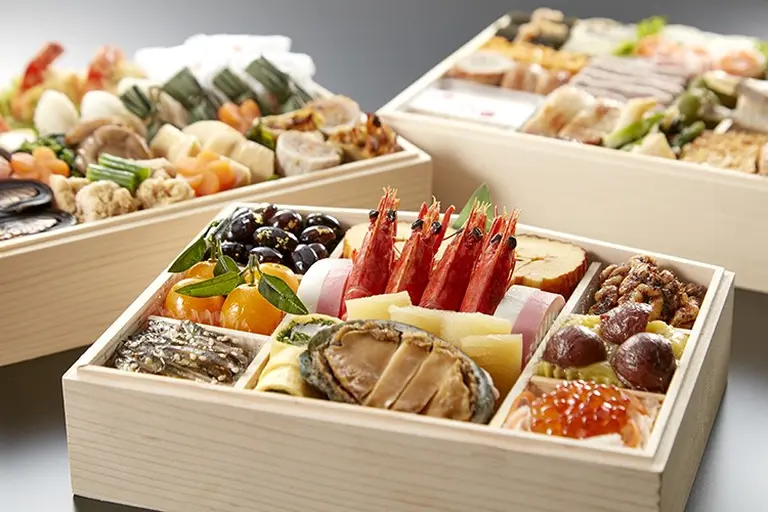Punakha Dzong, often called the “Palace of Great Happiness” or “Bliss,” is the administrative center of Punakha District in Bhutan. The fortress was built by Ngawang Namgyal, the founder of Bhutan, between 1637–1638. Originally named Puntang Dechen Phodrang Dzong, it is the second-oldest and second-largest dzong in Bhutan, as well as one of its most magnificent architectural masterpieces.
The fortress endured invasions by Tibetan forces in 1639 and 1644, but Bhutan successfully defended it. To commemorate these victories, the annual New Year festival was established, along with the construction of the Yu Gyal Gonkhang Chen Mo – the “Great Temple of the Victorious Protector.” Inside the temple, images of the battlefield and warriors are preserved.
Geographic Location of Punakha Dzong
The dzong sits at the confluence of the Pho Chhu (Father) and Mo Chhu (Mother) rivers in the Punakha–Wangdue Valley. The Mo Chhu originates from the northern hills of Lingshi and Laya in Bhutan and extends into Tibet, while the Pho Chhu is fed by glaciers from the Lunana region of the Punakha Valley. After merging, the river is known as Puna Tsang Chhu.
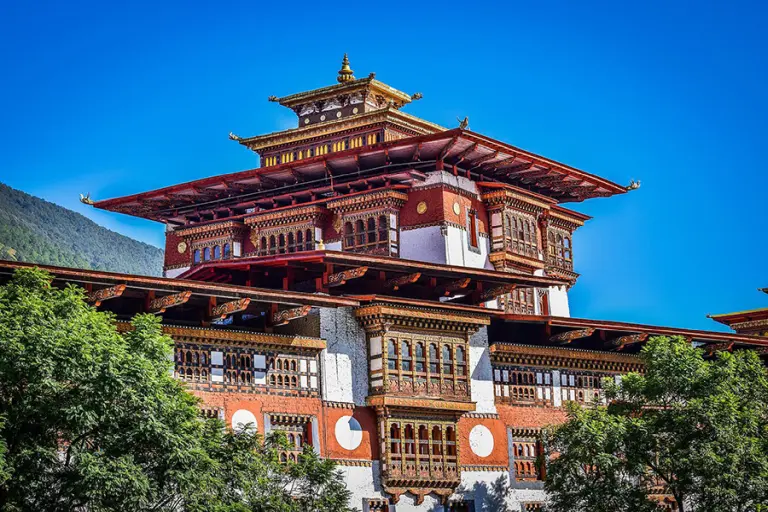
>> Must-Visit Attractions in Bhutan – Unlock the Magic of the Land of Thunder Dragon!
Thanks to its mild climate, Punakha serves as Bhutan’s winter capital. The Chief Abbot of Bhutan and his entourage of monks spend the winter at this dzong. Surrounding the fortress, jacaranda trees bloom in shades of lilac during springtime.
Nearby attractions include the longest suspension bridge in Bhutan, Punakha Suspension Bridge, and the fertility temple Chimi Lhakhang – located about 7.5 km (4.5 miles) away by car.
Architecture of Punakha Dzong
The Punakha Dzong is 180 meters long and 72 meters wide, with a central tower rising six stories high.
The main entrance is accessed via the Bazam Bridge, rebuilt in 2008 after the original 17th-century bridge was washed away in a 1958 flood. The chamber above the entrance showcases Bhutanese cantilever bridge design and its reconstruction history.
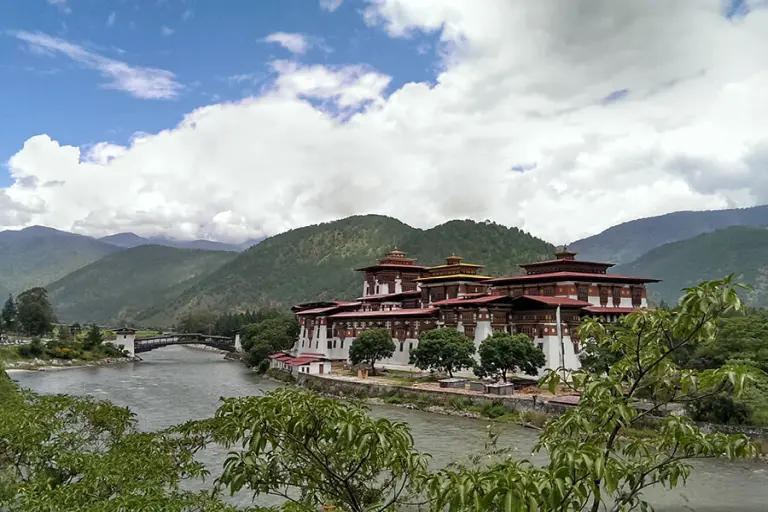
Unlike most dzongs, which usually have two courtyards, Punakha Dzong has three:
- The First Courtyard (north side): Houses the administrative offices, a sacred Bodhi tree, and a large white temple. In the far-left corner is a shrine dedicated to Tsochen, the Queen of Nagas (serpent spirits).
- The Second Courtyard: Reserved for monastic residences, separated from the first by the central tower. It contains two assembly halls. One of them was famously used when Ugyen Wangchuck, Bhutan’s first king, was awarded the Order of the Knight Commander of the Indian Empire in 1905 by John Claude White. The coronation ceremonies of Bhutanese kings are held here. In 2011, it also hosted the royal wedding of the Fifth King.
- The Third Courtyard: Houses sacred relics of the southern Drukpa Kagyu lineage of Tibetan Buddhism, including the Rangjung Kasarpani, relics of Ngawang Namgyal, and treasures of Tertön Pema Lingpa.
A smaller structure known as Dzong Chung (the “Little Dzong”), dating back to 1326, holds one of Bhutan’s earliest Buddha statues. Construction of the current dzong began in 1637 and was completed the following year. Weapons captured from the Tibetan invasions were preserved here, and Zhabdrung established a monastic body of 600 monks.
>> Photos reveal the beauty of Bhutan – The happiest country in the World
Legend has it that Guru Rinpoche prophesied the building of Punakha Dzong, predicting that a man named Namgyal would build a fortress on a hill shaped like a sleeping elephant. When Zhabdrung arrived in Punakha, he chose the elephant’s trunk – the site where the Pho Chhu and Mo Chhu meet – for its construction.
Over the centuries, the dzong has faced fires (the latest in 1986), a devastating earthquake in 1897, and damage from a glacial lake flood in 1994. Yet each time, it was restored to its grandeur.
Defensive features include steep wooden stairs designed to be pulled up and heavy wooden doors that are locked at night.
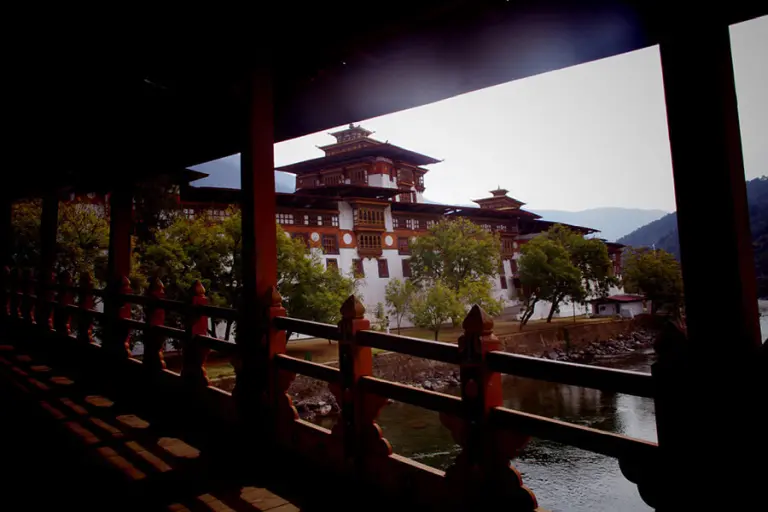
The Story of Punakha Dzong
At the southernmost courtyard lies the temple that enshrines the remains of Tertön Pema Lingpa and Zhabdrung Ngawang Namgyal. Zhabdrung passed away at Punakha Dzong, and his embalmed body is preserved in the Machey Lhakhang (literally “Sacred Embalmed Body Temple”), reconstructed in 1995. The coffin is permanently sealed, with only the King and the Je Khenpo (Chief Abbot) permitted to enter for blessings before assuming office.
>> Dzongkha – The language of happiness in Bhutan
Also in the southern courtyard is the Kunrey or “Hundred-Pillar Hall” (though it has only 54). This hall contains exceptional murals commissioned by Bhutan’s second Druk Desi, depicting the life of the Buddha. Inside stand massive gilded statues of the Buddha, Guru Rinpoche, and Zhabdrung, dating back to the mid-18th century. Golden carvings painted in red and black adorn the columns, creating a refined artistic elegance despite the hall’s monumental scale. It is also the only chapel consistently open to visitors.
One of Bhutan’s most treasured relics is the Rangjung Kharsapani (“Self-Created”), an image of Chenrezig (Avalokiteshvara) housed in the Tse Lhakhang of Punakha Dzong. Brought from Tibet by Zhabdrung, it plays a central role in the famous Punakha Dromchoe festival. However, it is never displayed to the public.

>> Religion in Bhutan – The mystical colors of spirituality
FAQ
What is Punakha Dzong and why is it so famous?
Punakha Dzong, often called the “Palace of Great Happiness,” is one of Bhutan’s most majestic fortresses. Built in 1637 by Ngawang Namgyal, the unifier of Bhutan, it is the second-oldest and second-largest dzong in the country but arguably the most beautiful. It sits at the confluence of two rivers, the Pho Chhu (Male River) and Mo Chhu (Female River), making it look like it floats above the water. The dzong has served as both a religious and administrative center, and it was the winter residence of Bhutan’s central monk body for centuries.
What makes Punakha Dzong architecturally unique?
The dzong showcases the finest example of Bhutanese fortress architecture, with towering whitewashed walls, intricately carved woodwork, golden roofs, and sweeping courtyards. The approach itself is dramatic: visitors cross a traditional cantilever wooden bridge before entering its massive gates. Inside, you’ll find elaborately decorated temples, sacred relics, and the Dzongchung (the “little dzong”), an older temple that predates the fortress itself.
Is Punakha Dzong historically important?
Absolutely. It was here that Bhutan’s first king was crowned in 1907, establishing the Wangchuck dynasty that still rules Bhutan today. It also hosted the wedding of the current king, Jigme Khesar Namgyel Wangchuck, and Queen Jetsun Pema in 2011, a celebration that drew worldwide attention. Beyond royal history, Punakha Dzong has been the stage for many pivotal events in Bhutan’s religious and political life.
Can tourists visit the inside of Punakha Dzong?
Yes, visitors are welcome, but entry is regulated to preserve its sacred nature. You can explore its courtyards, temples, assembly halls, and murals that tell Buddhist legends. Remember: dress modestly (no shorts or sleeveless shirts), remove your shoes before entering temples, and be mindful that this is still an active monastery and government office.
When is the best time to visit Punakha Dzong?
The most magical time to visit is during the Punakha Tshechu and Drubchen festivals, held in late winter or early spring (usually February or March). These vibrant events feature colorful masked dances, traditional music, and ancient rituals that celebrate Bhutan’s spiritual heritage. Outside of festival time, spring (March–May) and autumn (September–November) are the most comfortable seasons for travel, with blooming jacaranda trees adding even more beauty to the dzong’s setting.
How do you reach Punakha Dzong?
From Thimphu (the capital), Punakha is about a 3-hour drive through winding mountain roads, passing the famous Dochula Pass with its 108 memorial chortens and sweeping Himalayan views. The drive itself is breathtaking, making the journey as memorable as the destination.
Why is Punakha Dzong called the “Palace of Great Happiness”?
The name reflects not just its beauty but also its symbolic role in Bhutanese life. It was constructed at the meeting point of two rivers — a union believed to represent harmony, balance, and prosperity. Many locals say the dzong carries a peaceful energy, and Bhutanese people see it as a source of national pride and spiritual strength.
Are there any travel tips for visiting Punakha Dzong?
- Timing: Visit early in the morning to avoid crowds and enjoy the dzong in soft light.
- Dress Code: Respect Bhutanese cultural norms — long pants, covered shoulders, and no hats inside temples.
- Guides: Hire a local guide to fully understand the history, art, and symbolism behind what you see.
- Photography: Photos are allowed in courtyards but not inside temples. Always ask before snapping pictures of monks.
Punakha Dzong isn’t just a fortress; it’s a living monument to Bhutan’s history, spirituality, and timeless beauty. For many travelers, it’s the highlight of their Bhutan journey.


